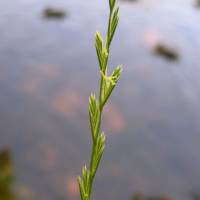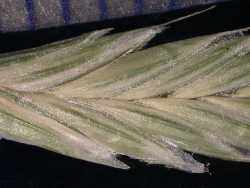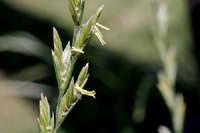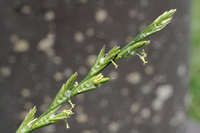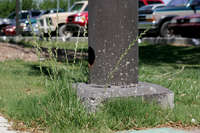This species is doubtless sparingly found throughout the state. It has been sown intentionally as an adulterant of grass seed in meadows and lawns. It is now found as an escape along roadsides, on the unkept borders of lawns, and in waste places. Besides one small colony which I have seen, I have no evidence to indicate that it is more than an occasional escape. Usually known in commerce as English Ryegrass.
Common Name: perennial ryegrass
Duration: Perennial
Nativity: Non-Native
Lifeform: Graminoid
General: Perennial with stems to 100 cm, erect to decumbent at base.
Vegetative: Blades dark green, glossy, 10-30 cm long, 2-4 mm wide, smooth to slightly scabrous above.
Inflorescence: Spikes 3-30 cm long with 5-37 spikelets, spikelets 5-22 mm long, 1-7 mm wide with 5-9 florets that are appressed to erect-spreading, rachis 0.5-2.5 mm thick at nodes, flattened, scabrous on angles; glumes 3.5-1.5 mm, half to three-quarters as long to exceeding the upper florets; lemmas 3.5-9 mm long, 1-2 mm wide, awnless or with a minute tip.
Ecology: Found in disturbed sites, widespread, introduced via cultivation; flowering May-September.
Distribution: Introduced to every continent and found throughout N. Amer., in every state in the US.
Notes: Distinguished by the flattened spikelets which are ranked alternately up a spike with the side towards the rachis lacking a glume and fitting into a groove in the rachis. Recent reorganization places this and other species previously in Lolium within Festuca.
Ethnobotany: Unknown
Etymology: Festuca is Latin for grass stalk or straw, while perennis means perennial.
Synonyms: None
Editor: SBuckley 2010, 2011, FSCoburn 2015
Mostly short-lived perennial; culms slender, 3-9(-12) dm; spike slender, 1-2 dm, the rachis scabrous on the margins and sometimes also on the back; spikelets (2-)5-22-fld; glume 4-12 mm, herbaceous, distinctly shorter than the spikelet; lemmas awned or awnless, the lowest 5-8 mm, the upper progressively reduced; 2n=14, 28. Native of Europe, cult. in meadows and lawns and often escaped onto roadsides and in waste places throughout our range and w. to the Pacific. Two well marked but wholly intergradient vars., apparently originating as agronomic strains.
Gleason, Henry A. & Cronquist, Arthur J. 1991. Manual of vascular plants of northeastern United States and adjacent Canada. lxxv + 910 pp.
©The New York Botanical Garden. All rights reserved. Used by permission.




